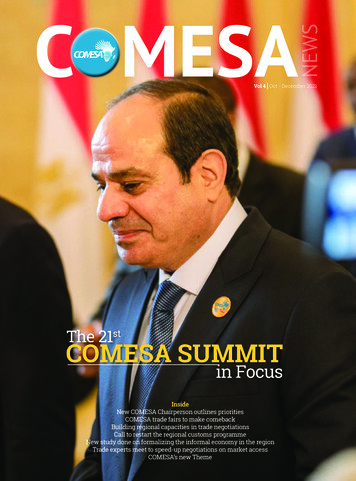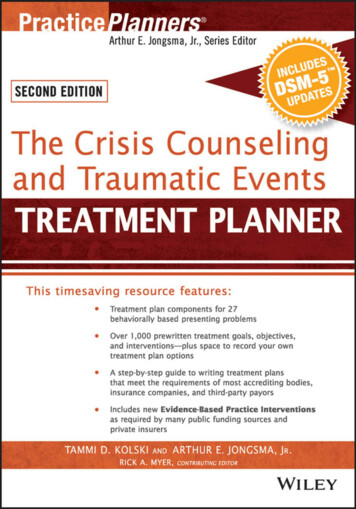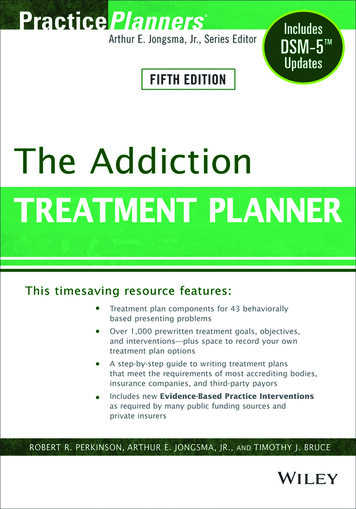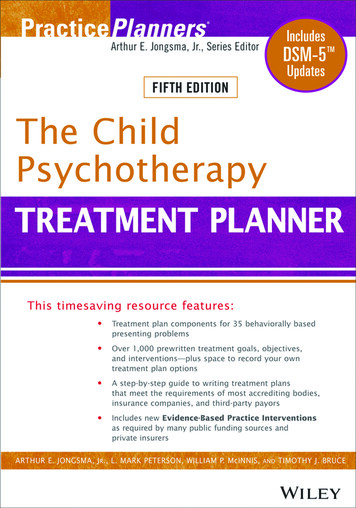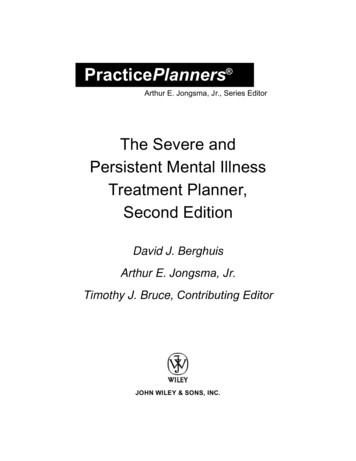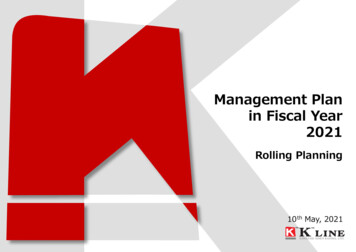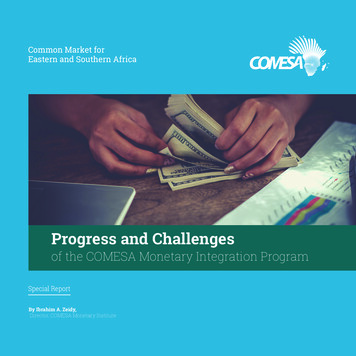
Transcription
Progress and Challenges of the COMESA Monetary Integration ProgramCommon Market forEastern and Southern AfricaProgress and Challengesof the COMESA Monetary Integration ProgramSpecial ReportBy Ibrahim A. Zeidy,Director, COMESA Monetary Institute1
This paper analyzes the progress that has been made in COMESA Monetary Integrationprogramme and identify challenges that are faced and provides the generic roadmap forachieving monetary unionProgress and Challengesof the COMESA Monetary Integration Program30 October 2021By Ibrahim A. Zeidy,Director, COMESA Monetary InstituteDisclaimer :The views expressed in this article are solely of the author and do not reflect the policy of COMESA. This article may bereproduced with acknowledgment of the source.
Progress and Challenges of the COMESA Monetary Integration ProgramBackgroundThe mandate to set up a Monetary Union in COMESA is derived from Article 4(4) of the COMESA Treaty signedin Kampala, Uganda on 5 November 1993 which states: COMESA Member states shall’ in the field of monetaryaffairs and finance, cooperate in monetary and financial matters and gradually establish convertibility of theircurrencies, irrevocable fixing of conversion rates as a basis for the eventual establishment of a Monetary Union.The COMESA Monetary cooperation programme considers fiscal and monetary discipline as the overridingprinciple for achieving macroeconomic convergence by requiring member countries to fulfil a set ofmacroeconomic convergence criteria, categorized as Primary criteria and Secondary criteria. The roadmapfor implementation of the new stages for achieving the Programme, which will culminate in Monetary Union by2035 is categorized based on the following three key pillars:Pillar I: Achieving macroeconomic convergence: This include statistical harmonization and implementation ofthe COMESA Multilateral Macroeconomic Surveillance Framework. This is aimed at ensuring the viability andsustainability of the COMESA Monetary Integration Agenda.Pillar II. Implementation of the COMESA Financial System Development and Stability Plan: The main objective ofthis pillar is to achieve Regional Financial Integration (RFI), which is needed to facilitate the financing of larger realtransactions at a regional level. This is key to enhance the implementation of the COMESA’s long-term objectiveof creating a single market in financial services to support regional integration This will also significantly help toenhance the implementation of African Continental Free Trade Area.Pillar III. Institutional, administrative, and legal preparations for the creation of the COMESA Monetary Union.The objective of this paper is to analyze the progress that has been made in the COMESA Monetary Integrationprogramme and identify challenges that are faced. The first part of the paper briefly provides the generic roadmapfor achieving monetary union. The second part then proceeds to assess the progress made by COMESA inevaluating the implementation status of the following:I.II.Convergence and harmonization of macroeconomic policies and implementation of COMESAMultilateral Macroeconomic Surveillance Framework;Implementation of the COMESA Financial System Development and Stability Plan;1
2III.IV.Harmonisation of concepts, definitions of macroeconomic data; andDevelopments in trade integration.The paper also summarizes key challenges and provides recommendations on the way forward in section (III)and section (IV).I.Generic Roadmap for Achieving Monetary Union1The generic roadmap for achieving monetary union, envisage the following five hybrid stages:(a)Preparatory stage: This stage includes modernizing the domestic financial system including thepayment system;(b)Harmonisation stage: Modernization of the financial sector in individual countries would be furtherextended by the introduction of and compliance with various international standards and practices inthe financial sector that would ensure regional harmonization.(c)Cooperation stage: Member countries cooperate in effectively implementing agreed convergencecriteria that are monitored and evaluated by a regional Convergence Council. They also complete thefull harmonization process relating to regulatory, supervisory, and accounting procedures which beganunder stage II, and cooperate in cross border regulations and supervisory activities.(d)Integration stage: In this stage, the focus will be shifted to a regional level. This will be characterized byan effective integration of various financial institutions to achieve Regional Financial Integration, and ofthe exercise of regulatory and supervisory functions, including single bank licensing, a single regulatoryagency, and increased cross-border presence of financial institutions originating in member countries.(e)Unification/Monetary Union stage: Integration would be characterized by common currency and acommon central bank. A roadmap towards a monetary union will be a fusion of the real economicintegration and regional financial integration processes. This includes policy and institutional stepsthat need to be taken in both the real and financial sector in moving towards establishing monetaryunion. Almost all regional cooperation arrangements aiming at the formation of monetary unionhave followed sequential process. between Regional Economic Integration and Regional Financial1AfDB &COMESA “Facilitating Multilateral Fiscal Surveillance: In Monetary Union Context: With Focus on COMESA Region, pp 6-9.
Progress and Challenges of the COMESA Monetary Integration ProgramIntegration. Economic and Monetary Union (EMU) started with sectoral real integration (coal and steel)and gradually progressed towards economic community and the economic and monetary union. Thetwo CFA currency unions in Africa began with the establishment of a currency union and then proceededto establish monetary union (WAEMU and CEMAC) by setting up customs union and other elements ofeconomic community among their member countries. COMESA follows EMU precedent, establishingFTA, Customs Union and Economic Union in sequential order to achieve monetary union.II.Assessment of progress made by COMESA on the Implementation of the COMESA MonetaryIntegration Programme(a)Assessment of the Status on the Convergence scale and the Implementation of the COMESAMultilateral Macroeconomic Surveillance FrameworkThe assessment of primary and secondary criteria generally indicates the following: Fiscal deficit, Inflation and external reserves (in months of imports) criteria remained the mostchallenging for member countries.Member States performance was not satisfactory on achieving stable exchange rates.Monetary policy stance varied depending on the individual circumstances in the member countriesbut generally remained focused on controlling inflation.A number of Member States responded to higher inflation and currency depreciation by raisingpolicy interest rates.Significant depreciation of currencies was observed in a number of member countries in recentyears, primarily owing to high public sector demand for foreign exchange to finance big publicinvestment projects, a strong dollar and high demand for foreign exchange from the localcorporate sector and other importing enterprisesAs per the requirements of the COMESA Multilateral Macroeconomic Surveillance Framework, key achievementsinclude the following: Regarding, fiscal transparency and accountability, most countries currently have Public FinanceManagement Act (PFM);3
4 (b)Many member countries prepare Medium Term Financial Frameworks – many countries havealso national fiscal rules;There is significant improvement in revenue administration, cash flow planning and procurement.Assessment of Member Countries in the Implementation of the COMESA Financial SystemDevelopment and Stability PlanThe Financial system in most member countries had undergone significant reforms with progress recorded inbanking and insurance. The following are some of the achievements:--To modernise payment systems many member countries have introduced RTGS electronicpayment system.COMESA has a Regional Payment and Settlement System which is fully operational.COMESA Member States have also seen an increase in the number and operations of microfinanceinstitutions (MFIs). Banks have also started to focus more on broadening access to retail bankingthrough introduction of mobile banking operations. Some banks for example, Equity Bank in Kenyahave their business model on low-end customers. Many banks are also broadening their branchnetwork.There is high degree of compliance by many member countries to the core principles of banksupervision and regulation that are applicable to them. Some are in partial compliance to theprinciples.Most countries are implementing Basel I, and some Basel II, although there are challenges.Quoting and trading in the COMESA national currencies by deposit money banks is highly limitedin most countries except to some extent in member countries which are also members of EAC.Regulatory framework for insurance and pension schemes is less developed in most membercountries of the COMESA region.While most countries require the use of International Financial Reporting Standards (IFRS) forfinancial sector enterprises, they are deficient in application, in part because of lack of sufficientlytrained personnel and the absence of enforcement mechanism.COMESA regional financial institutions such as Trade and Development Bank, PTA ReinsuranceCompany and African Trade Insurance Company are making great contributions in enhancing theCOMESA regional integration agenda.
Progress and Challenges of the COMESA Monetary Integration ProgramThe following are achievements towards assuring financial stability in the region:-Most member Central Banks established the financial stability unit;Many member Central Banks publish financial stability reportsSome countries established Credit Reference Bureaus.All member Central Banks produce data on Financial Soundness Indicators.Some countries are undertaking systemic risk assessment using bank stability index, financialstress index, heat map and cobweb. Some also are undertaking micro and macro stress testing.COMESA Monetary Institute (CMI) has provided and is providing capacity building and research activities thatare related to improving macroeconomic management and financial stability with the aim of enhancing theCOMESA Monetary Cooperation Programme, focusing mainly on the implementation of the COMESA MultilateralMacroeconomic Surveillance Framework and the COMESA Financial System Development and StabilityPlan. CMI has also developed a number of User’s Guides which will assist member countries for undertakingmacroeconomic analysis and for assessing stability of the financial system.(c)Assessment of Member Countries on Harmonisation of Statistics-(d)Most Member States are making progress towards implementing SNA 93.COMESA has operationalized a Consumer Price Index harmonization Project (HCPI) with thesupport of African Development Bank.Member countries are quite advanced in the use of the Customs Declaration Information Systemsoftware (ASYCUDA) and in the use of EUROTRACE for external trade statistics.The compilation of monetary statistics in most member countries is in accordance with the IMF‘sMonetary and Financial Statistics Manual.The periodicity and timeliness of the monetary survey broadly follow the General DataDissemination Standards (GDDS) recommendations.The main areas where measurement problems still exist are with inflation, the fiscal out turn andthe determination of central bank financing of fiscal deficit.Assessment of Member Countries in Trade Integration5
6The following are key achievements in trade integrationa)b)c)d)e)f)COMESA formed a Free Trade Area (FTA) in October 2000 in which 16 member countries out of21 are currently participating.COMESA also launched a Customs Union in 2009.The top priority for implementation of Customs Union by member states is to finalize domesticationof the COMESA Common Tariff Nomenclature/Common External Tariff (CTN/CET) to HS 2012version and migrate to COMESA Customs regulations (CMRs.)There is a great effort to resolve non-tariff barriers through various avenues which includedbilateral meetings held in the margins of the Regional NTBs as well trade and customs meetings.COMESA is implementing the Standards and Quality Assurance (SQA) and Sanitary and PhytoSanitary (SPS) programmes.COMESA Secretariat is implementing programmes to improve the transport and communicationssystems of the region as well as improve information available to businessmen wishing to tradeboth within the region and beyond. They include among others the following:- Harmonised Road Transit Charges;COMESA Carrier’s License;Harmonised Axle Loading and Maximum Vehicle Dimensions;The Regional Customs Transit Guarantee Scheme, andThe Yellow Card.The Member States of COMESA, the EAC and SADC agreed in October 2008 to negotiate a Tripartite FreeTrade Area (TFTA) in Kampala, Uganda. The Heads of State and Government of the COMESA, EAC andSADC also met again on 10 June 2015 in Sharm El Sheikh, Egypt at the Third Tripartite Summit to officiallylaunch the COMESA-EAC-SADC Tripartite Free Trade Area (TFTA). The harmonization and coordinatingof regional programmes in the three RECs will play a pivotal role in not only boosting intra-African tradebut also in rationalizing use of resources and cooperation among the Regional Economic Communities(RECs). The TFTA stands as part of a much more ambitious agenda to establish a continental FTA (orAfCFTA) covering the whole of Africa.
Progress and Challenges of the COMESA Monetary Integration ProgramiII.Key Challenges for Achieving COMESA Monetary Integration Programme-----IV.Achievement of the convergence criteria on a sustainable basis continued to pose a seriouschallenge for most countries. The fiscal deficit and inflation criteria remained the most challenging.In some Member States fiscal and monetary policy coordination remained weak leading to highinterest rates, exchange rate pressures and rapid inflation.The COMESA Macroeconomic Multilateral Surveillance Framework is not yet fully implemented.The level of intra-COMESA trade remained low, partly on account of poor transport network,unstable power and water supply, as well as the existence of some non-tariff barriers.Quoting and trading in the COMESA national currencies by deposit money banks remained limited,partly due to the absence of stable exchange rates and the lack of a mechanism for clearing andsettling of accumulated long positions of banks.Although the financial sector remained stable and sound in many member countries, the financialmarkets are characterized by; low savings rates, underdeveloped bond markets, limited investorbase, lack of modernised payment system in some countries, lack of cross-border supervision offinancial markets etc.COMESA economies are prone to relatively large and asymmetric shocks, including terms of tradeand exchange rate shocks, with implications for the real economy. The existence of asymmetricshock would pose a challenge for the effective implementation of monetary policy in the zone.Some countries were heavily dependent on unpredictable aid inflows to finance a substantialportion of government expenditure. Reliance on such aid inflows for budgetary support constrainsthe attainment of the fiscal deficit to GDP (excluding grants) criterion on a sustainable basis.In order to facilitate better assessment of the integration process and for purposes of comparisonof convergence indicators across member countries, reliable, timely and harmonised statisticalinformation is required. This can be mitigated by encouraging member countries to adopt bestinternational standards of compiling macroeconomic data.Lack of sufficiently trained manpower to implement internationally accepted standards.Recommendations on the Way ForwardThe following are key recommendations on the way forward:7
8----There is need for the implementation of macroeconomic surveillance framework that overseescompliance and is endowed with appropriate instruments to enforce compliance.The surveillance mechanism should be supported by an effective legal framework, which couldserve as a commitment technology for macroeconomic stability and policy credibility.The role of the surveillance framework should be that of “promoter” (assisting member countriesto fulfil their obligations and a crisis manager. Assistance should be more prominent duringearlier stages of monetary cooperation, followed by gradually assigning growing importance tosanctions as integration intensifies.Surveillance mechanism should pay special attention to Public Finance Management (PFM)systems in member countries. It is necessary to ensure that member countries of monetaryunion possess a minimum standard of efficient PFM system in the interest of convergence andsustainability of the union.Encouraging member countries to formulate their budgetary policies within a comprehensiveMedium Term Financial Framework, comprising a set of four separate frameworks: MediumTerm Macroeconomic Framework, a Medium-Term Fiscal Framework, a Medium-Term BudgetFramework, and a Medium-Term Expenditure FrameworkSince monetary union is a fusion of two integration processes, namely real and financial, it isnecessary that trade integration its formulation and implementation be embedded as a parallel, ifnot an integral part of macroeconomic surveillance framework.
Progress and Challenges of the COMESA Monetary Integration Program9
10Since the last situational update on 14 April 2020, 1,049 new cases have been recorded in COMESA region.IntroductionWhilevaluethe totalnumberof casesis nowat 5,659,the active casesare currently3,902. andIt shouldbe notedGlobalchains(GVCs)havebecomea dominantfeatureof worldat tradeinvestment,that the rate of increase in the region has been high since 21 March 2020. The increase is associated withencompassing developing, emerging, and developed economies starting in the 1980s. The process ofenhanced testing by most of the Member States.producing goods, from raw materials to finished products, is increasingly fragmented and carried outwherever the necessary skills and materials are available at competitive cost and quality.Companies, both large and small, can participate in GVCs by engaging in one of the many types ofactivities performed in a coordinated fashion across several countries to bring a product fromconception to end-use. These activities might include farming, extraction of natural resources, researchand development, different types of manufacturing, design, management, marketing, distribution, postsale services, and many others. Participating in GVCs does not necessarily mean directly trading goodsor services across borders, but rather is linked to such activities through the process of value creation.Depending on the type of product and geographical location of different activities, some value chainswill be regional, while others will have a truly global nature.COMESA SECRETARIATCOMESA CenterCountries in Asia and Latin America which were tightly integrated into global value chains (GVCs) haveBen Bella Roadreaped significant benefits in terms of productivity improvements, job creation, and poverty reduction.P.O. Box 30051Countries in Africa that had weak links into GVCs or were mostly operating at the lower end of the valuechain 260providingraw materials have not benefited as much from this trade-led growth.211 229primary725www.comesa.intRegionalOrganisations in Africa are beginning to take initiatives on industrialization. For example,The Common Market for Eastern and Southern Africa (COMESA), the East African Community (EAC),info@comesa.intand Southern Africa Development Community (SADC) have industrialization strategies, independentlyand aspart of their Joint Tripartite Free Trade Area arrangement. The 26 member countries of thefacebook.com/COMESA/Tripartite Arrangement seek to strengthen co-ordination in industrial policy. This includes developing@twitter.com/comesa lusakaand upgradingRegional Value Chains (RVCs), which would enhance production capacity andcompetitiveness.The African Continental Free Trade Area (AfCFTA) also offers a tremendous opportunity to integrateAfrica’s firms into the global supply chains and create new ones for the region. Well-developed regional
and gradually progressed towards economic community and the economic and monetary union. The two CFA currency unions in Africa began with the establishment of a currency union and then proceeded to establish monetary union (WAEMU and CEMAC) by setting up customs union and other elements of economic community among their member countries.
